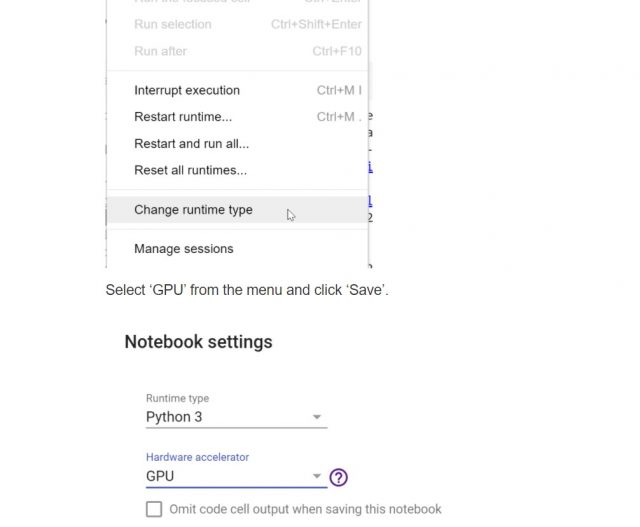
In this post, you will get information regarding the online Jupyter notebooks platform (GPU-based) which you can use to get started with both, machine learning and deep learning. The list consists of both freely available and paid options of online Jupyter notebook available with GPUs. When starting with GPUs, it is recommended to use rented options available online rather than buying your own GPU servers. There are online GPU Linux servers available (free and paid options) that can be used to train deep learning & machine learning models. I will be writing about it in my next post.
Here is the list of Jupyter notebook platforms that could be used for training deep learning models:
- Google Colab: Google Colab provides GPU-powered notebooks for free. While using Google Colab notebook, you need to change the runtime type by clicking on the ‘Runtime’ tab and selecting ‘Change runtime type’. A pop-up window will open up with a drop-down menu. Select the hardware accelerator as “GPU” in the pop-up window.

Fig 1. Google colab change runtime to GPU
- Amazon Sagemaker: Amazon sagemaker is an Amazon service that provides Jupyter notebooks with elastic compute and sharing. You need an AWS account setup to get started with Amazon Sagemaker. You can instantiate a GPU-powered SageMaker Notebook Instance, for example, ml.p2.xlarge (NVIDIA K80) in $1.125/hour or ml.p3.2xlarge (NVIDIA V100) in $3.825/hour. You can get great development experience in relation to training deep learning models with GPU running right under the notebooks. Access the detailed pricing here.
- Kaggle: Kaggle provides free access to NVIDIA TESLA P100 GPUs. These GPUs are useful for training deep learning models, though they do not accelerate most other workflows (i.e. libraries like pandas and scikit-learn do not benefit from access to GPUs).
- DataCrunch: Datacrunch.io provides GPU-powered jupyter notebooks at a very low price starting with $1.1/hour with the option of paying on usage per 10 minutes. The information on different products is listed here.
- Gradient: Gradient includes a suite of tools including 1-click Jupyter notebooks which runs on Paperspace, a GPU-accelerated cloud platform. Paperspace provides gradient community notebooks which are public & shareable Jupyter Notebooks that run on free cloud GPUs and CPUs. Paperspace also provides CORE which provides a fully-managed cloud GPU platform. With CORE, you can get access to low-cost GPUs in as little as $0.18/hour. Here is an introductory video on Gradient.
Here are few cautions you would need to take when running paid GPU notebook servers:
- GPU must only be turned on if you plan on using the GPU for training models that take advantage of GPU-accelerated libraries such as TensorFlow, PyTorch, etc.
- Monitor and manage GPU usage in an active manner.
- Coefficient of Variation in Regression Modelling: Example - November 9, 2025
- Chunking Strategies for RAG with Examples - November 2, 2025
- RAG Pipeline: 6 Steps for Creating Naive RAG App - November 1, 2025
Thanks, @Ajitesh Kumar for writing this post. You can also check out jarvislabs.ai the 1-click GPU Cloud platform which also has modern GPUs like A100, A6000, and RTX5000/6000 at unseen prices with pay-per-minute billing.